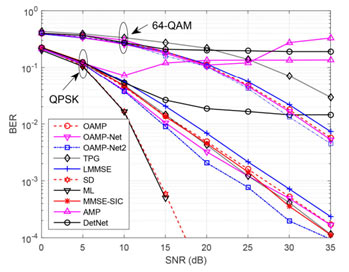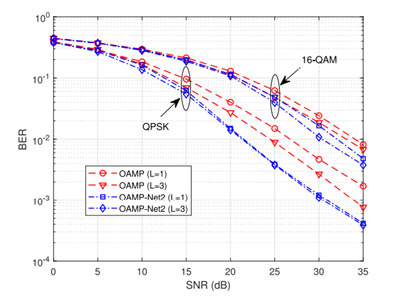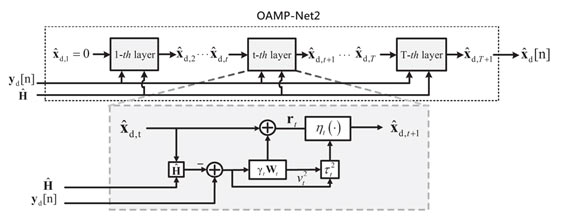
Contributed by Dr. Hengtao He, based on the IEEEXplore® article, H. He, C.-K. Wen, S. Jin, and G. Y. Li, "Model-driven deep learning for MIMO detection," IEEE Transactions on Signal Processing, vol. 68, pp. 1702–1715, Feb. 2020 and the SPS webinar, "Model-driven Deep Learning for MIMO Detection." available on the SPS Resource Center.
Multiple-input multiple-output (MIMO) technology can dramatically improve the spectral efficiency and link reliability and has been applied to many wireless communication systems. To obtain the benefits of MIMO, efficient channel estimation and signal detection algorithms, which balance performance and complexity, are essential in receiver design and have arouse a series of research [1]. With excellent performance and moderate complexity, iterative detectors, based on orthogonal approximate message passing (AMP) algorithms, have been proposed for MIMO detection. However, for practical MIMO systems, the performance of these iterative detectors is still far from Bayes-optimal solution and has serious deterioration with correlated MIMO channels and imperfect channel state information (CSI). Recently, deep learning (DL) has been applied in physical layer communications [2], such as channel estimation [3], CSI feedback [4], signal detection [5], [6], and precoding design [7]. By incorporating domain knowledge into network design, model-driven DL can reduce the demand for computing resources and training time, which is more attractive for wireless communications, especially for MIMO detection.
Model-Driven Deep Learning

Fig. 1. Components of the model-driven DL approach [2].
As illustrated in Fig. 1, the model-driven DL comprises three parts: a model, an approach (algorithm), and a network for a specific task [2]. The model is constructed based on the background knowledge, including the physical mechanisms and domain knowledge. An approach (i.e., feasible algorithm and theory) based on the aforementioned model and domain knowledge is then designed to solve the problem. This approach is then employed to obtain a deep network with several learnable parameters that are trained via a back-propagation algorithm similar to data-driven DL. In many cases, the network is constructed by unfolding an iterative algorithm into a signal flow graph, using the accessible algorithm as an initialization step and combining it with a standard neural network, or mimicking the conventional structure of the model-driven method. Model-driven DL approaches are attractive for physical layer communications as it inherits the advantages of the model-driven approaches and avoids the requirements for accurate modeling. Furthermore, model-driven DL has other benefits, such as its low demand for training data, reduced risk of overfitting, and rapid implementation.
Model-Driven DL Detector
Fig. 2. Block diagram of OAMP-Net2 detector [6].
The structure of the OAMP-Net2 is illustrated in Fig. 2, which is obtained by unfolding the OAMP detector and adding several trainable parameters [6]. The network consists of several cascade layers and each has the same architecture but different trainable parameters. Each layer of the OAMP-Net2 contains the linear and nonlinear estimators, error estimators, and learnable variables. The number of trainable variables of the OAMP-Net2 is independent of the number of antennas, and only determined by the number of layers. This is an advantageous feature for large-scale problems, such as massive MIMO detection. With only few trainable variables, the stability and speed of convergence can be improved in the training process.
Joint Channel estimation and Signal Detection
As in Fig. 3, we consider an OAMP-Net2-based turbo-like joint channel estimation and signal detection (JCESD) architecture for MIMO systems, which shares the same spirit as iterative decoding [6]. In JCESD, channel estimator and signal detector exchange information iteratively until convergence. In the first iteration, pilot-only based channel estimation is performed. In the subsequent iterations, data-aided channel estimation is employed with the help of the detected data. Compared with the conventional receiver design where the channel estimator and signal detector are designed separately, this architecture can improve the performance of the receiver by considering the characteristics of channel estimation error in addition to channel statistics when performing signal detection and using the estimated payload data for channel estimation.

Fig. 3: The diagram of the turbo-like JCESD architecture [6].

Fig. 4: BERs performance comparison of the OAMP-Net2 with other MIMO detectors [6].
Fig. 4 compares the BER performance of the OAMP-Net2 with other MIMO detectors. From the figure, the OAMP-Net2 outperforms other MIMO detectors except for SD and ML, but the computational complexity of the ML and SD detectors is prohibitive. The DetNet and AMP detectors have serious performance deterioration in small-size MIMO systems. Furthermore, the OAMP-Net, TPG, and OAMP-Net2 detectors outperform the OAMP detector in all setting, which demonstrates DL can improve the OAMP detector by learning the optimal parameters.

Fig. 5: BERs performance comparison of the OAMP-Net2 with other MIMO detectors [6].
Fig. 5 shows the BERs of the OAMP and OAMPNet2 detectors in the JCESD architecture with orthogonal pilot, where L = 1 means no data feedback to channel estimator and L = 3 means the detected data are feedback twice to channel estimator. From the figure, the OAMP-Net2 detector outperforms the OAMP detector in all settings significantly. Furthermore, we observe that OAMP-Net2 detector without data feedback (L = 1) outperforms OAMP detector with data feedback twice (L = 3), which demonstrates learning some trainable variables can compensate for the channel estimation error to improve the equivalent SNR in detection stage.
References:
[1] S. Yang and L. Hanzo, “Fifty years of MIMO detection: The road to largescale MIMOs,” IEEE Commun. Surveys Tuts., vol. 17, no. 4, pp. 1941– 1988, Oct.-Dec. 2015, doi: https://dx.doi.org/10.1109/COMST.2015.2475242.
[2] H. He, S. Jin, C.-K. Wen, F. Gao, G. Y. Li, and Z. Xu, “Model-driven deep learning for physical layer communications,” IEEE Wireless Communications, vol. 26, no. 5, pp. 77-83, Oct. 2019, doi: https://dx.doi.org/10.1109/MWC.2019.1800447.
[3] H. He, C.-K. Wen, S. Jin, and G. Y. Li, ‘‘Deep learning-based channel estimation for beamspace mmWave massive MIMO systems,’’ IEEE Wireless Commun. Lett., vol. 7, no. 5, pp. 852–855, Oct. 2018, doi: https://dx.doi.org/10.1109/LWC.2020.3019321.
[4] C.-K. Wen, W. T. Shih, and S. Jin, “Deep Learning for Massive MIMO CSI Feedback,” IEEE Wireless Commun. Lett., vol. 7, no. 5, pp. 748–751, Oct. 2018, doi: https://dx.doi.org/10.1109/LWC.2018.2818160.
[5] H. He, C. Wen, S. Jin, and G. Y. Li, “A model-driven deep learning network for MIMO detection,” in Proc. IEEE Glob. Conf. on Signal and Inf. Process. (GlobalSIP), USA, Nov 2018, pp. 584–588, doi: https://dx.doi.org/10.1109/GlobalSIP.2018.8646357.
[6] H. He, C.-K. Wen, S. Jin, and G. Y. Li, “Model-driven deep learning for MIMO detection,” IEEE Trans. Signal Process., vol. 68, pp. 1702–1715, Mar. 2020, doi: https://dx.doi.org/10.1109/TSP.2020.2976585
[7] H. He, M. Zhang, S. Jin, C.-K. Wen, and G. Y. Li, “Model-driven deep learning for massive MU-MIMO with finite-alphabet precoding,” IEEE Commun. Lett., vol. 24, no. 10, pp. 2216-2220, Oct. 2020, doi: https://dx.doi.org/10.1109/LCOMM.2020.3002082.

